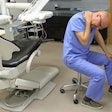
The Well-Being Index (WBI) may effectively screen for distress levels, including burnout, extreme fatigue, and suicidal thoughts among U.S. dentists, identifying those who would benefit from professional evaluation. The study was published in BDJ Open.
Dentists who have grappled with varying levels of distress exhibited elevated WBI scores that correlated with adverse workplace events as well as their intentions to leave their jobs, the authors wrote.
“Assessing the prevalence of burnout and other forms of distress among dentists at an individual level as well as at an organizational level may be critical to advancing interventions aimed at reducing work stress and improving the work environment,” wrote the authors, led by Dr. Subha Giri of the Mayo Clinic Department of Dental Specialties, (BDJ Open, January 16, 2024, Vol. 10:3).
Globally, the prevalence of burnout among dentists ranges between 7% and 84% and may be caused by many stressors, including long hours, practice inefficiencies, personal problems, and at-home conflict. The ramifications of burnout may include dental errors, malpractice, and employee turnover.
To gauge the effectiveness of the WBI screening tool, 587 dentists filled out a nine-item web-based survey and submitted to other tools gauging their quality of life (QOL), fatigue, burnout. Participants also responded to inquiries about suicidal thoughts, recent dental errors, and their plans to change jobs.
Dentists experiencing low QOL exhibited a significantly higher mean WBI score (4.1) compared to their counterparts without low QOL (1.6). Dentists who reported a recent major dental error (3.4 ± 2.3) had a notably higher mean WBI score compared to those without such incidents (2.0 ± 2.5; p < 0.001), the authors wrote.
Additionally, dentists who reported intending to leave their current jobs within 24 months had significantly higher average WBI scores (3.9 ± 2.2) compared to those without such intent (1.8 ± 2.4; p < 0.001). Furthermore, clinicians experiencing extreme fatigue, burnout, and suicidal thoughts showed significantly higher mean WBI scores compared to those without such distress (all p < 0.001), they wrote.
However, the study was not without limitations, including that most of the participants were general dentists affiliated with dental service organizations or group dentists. Therefore, practice owners or those in specialty practices were not adequately represented, which affect the generalizability of the findings, they wrote.
Though the screening tool may be useful in evaluating well-being in dentists, more studies are needed.
“Additional research dedicated toward further understanding the various contributing factors influencing dentists’ well-being and defining organizational strategies to address dentists’ well-being is warranted,” Giri et al wrote.




















